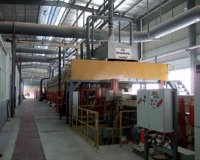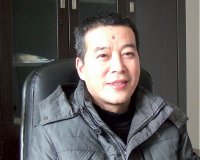New entrant to world of continuous pressing
19 June 2012Tianmen Tianyuan Wood Industry Co Ltd entered the continuous pressing of MDF in 2011 for the first time, but it seems it may have plans to increase its presence in the panel market before long, as Mike Botting discovered
The town of Xiantao, 70km west of Wuhan (capital of Hubei province) is home to the MDF factory owned by Mr Guan Keqin.
Mr Guan began in the MDF business by importing board in the early years of the 21st century when he worked for Luyuan in Zhejiang province and then decided to manufacture his own board.
"Through my experience of importing MDF, and knowing that we have the wood raw material available around here, I decided to enter the market for myself," said Mr Guan.
Like many people who are taking their first steps into the world of making MDF, he started by buying a multi-opening press line from Shanghai Wood Based Panel machinery Co Ltd (SWPM), with construction starting in 2005 and the line going into production in 2007.
This line had a 20-daylight press and a capacity of around 40,000m3/year. All the equipment came from Chinese suppliers, including the refiner, and the line is still running today.
"I decided in 2009 to buy an imported MDF line for two main reasons: The German-made lines can produce higher quality board; and they are more efficient in the use of all raw materials - wood, resin, energy and so on," said Mr Guan.
So how did he choose the supplier of his new line?
"I went to other Chinese MDF producers and saw what they were doing and looked at both Siempelkamp and Dieffenbacher imported lines. Both have their advantages and I think their quality is about the same, but in the end I decided to place the contract with Siempelkamp."
Finance was arranged through private investment, with Mr Guan raising the funds, and through a small bank loan.
The order was placed with Siempelkamp in May 2009 for a turnkey contract right through to start-up of the line.
Construction began on site in 2010 and the first machinery was delivered at the end of that year. First board was produced on April 28, 2011, with full production following in mid-May.
"We have been running ever since, with no problems," said Mr Guan.
Although Mr Guan said this was a turnkey contract, not all the machinery was imported. Debarker, chippers, dryer and sizing saw were from Chinese suppliers, as was the energy system, which came from Union Boiler in Changzhou. The 54in refiner came from Andritz of Austria.
Forming is by CMC Texpan, part of the Siempelkamp group, and the Siempelkamp ContiRoll continuous press is 4ft wide and 33.8m long.
There is a Weko water spray onto the mat before the press.
Quality control on the line is limited and supplied by a Chinese company in Shanghai.
Designed capacity of the line is 400- 450,000m3/year.
Sanding came from another Chinese supplier, Sufoma, but the cut-to-size angular saw system was imported from Giben of Italy.
"We can produce 2 to 20mm thickness board, but we mainly produce 4 to 9mm," said Mr Guan. "This is for furniture making and house remodeling. We mainly supply to the north of the country - Inner Mongolia, Hebei and some to Hubei and to Xinjiang, but not so much [to those provinces].
"There are furniture producers in Hubei, but they are low quality and want cheap MDF. Our quality is too high for them - they always want the cheapest price," pointed out Mr Guan.
Tianmen does not produce any value added panels, just raw MDF. "It would be hard to integrate value adding into our production and very costly," he said. Turning to the markets in general, Mr Guan sees changes going on.
"The market is shrinking a bit in terms of volume produced and in a few years I would not go into MDF from scratch again - the market is becoming saturated and is slowing down already.
"There is a slight connection to the [Chinese] economy generally, but it is mainly due to over-capacity in the MDF market as production has been exploding, leading to over-production."
What about particleboard rather than MDF?
"The first generation of particleboard producers had domestic equipment and made very poor quality board," said Mr Guan. "There are only three or four high-quality producers [using imported lines], but if you want to move into that market, the investment is high for good quality production so you would have to take a long-term view.
"Traditionally the Chinese market does prefer MDF, but furniture producers are beginning to change their preference towards particleboard, especially for cabinets and book shelves where particleboard is better than MDF, if moulding is not required."
In spite of all his reservations, Mr Guan said he will be considering next year a 300,000m3 particleboard plant, which will be an imported line, but this is only at a very tentative stage at present.
"If it does go ahead, we will consider both Siempelkamp and Dieffenbacher as machinery suppliers and production would be in 2014."
Proximity to markets and raw material is always an important balancing act in deciding where to build a panel mill and what annual capacity to go for. It would appear that Tianmen has gone for raw material over markets in establishing its base here in Hubei.
"Our wood comes from a 100km radius," said Mr Guan. "This area has a lot of plantations which are all privately owned and it is a good area for tree growing. The farmers work on a five or six year rotation and there is more than enough wood for a particleboard line if we were to decide to go ahead.
"The government is very strict on the control of wood cutting and can give regions money not to cut wood for another year [to encourage sustainability].
"However, Guangxi and Guangdong in the south, where there is also a lot of wood, and this area, up to Henan and Shangdong, is where most plantations are privately run with no such government intervention."
Like all Chinese factories, Tianmen makes its own resin and produces E1 grade board.
"We could produce E0 but there is no demand for it at all at present," said Mr Guan.
With regard to emissions laws for the factory itself, Mr Guan said the rule is maximum 50mg/m3 of dust, but that "nobody looks that closely."
Transport is mainly by truck, except to distant provinces like Xinjiang in the far west, where rail makes more sense.

